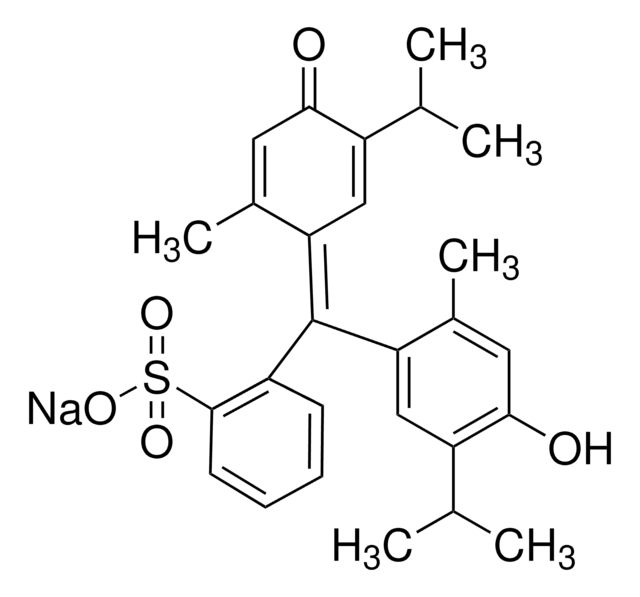1.08176
Thymolblau
pH indicator, ACS, Reag. Ph Eur
Synonym(e):
Thymolblau, Thymolsulfonphthalein
About This Item
Empfohlene Produkte
Produktbezeichnung
Thymolblau, indicator ACS, Reag. Ph Eur
Qualität
ACS reagent
Qualitätsniveau
Agentur
reag. Ph. Eur.
Form
solid
Verlust
≤3% loss on drying, 110°C
visual transition interval
1.2-2.8, red-violet to brownish-yellow(1st transition range)
7.8-9.5, greenish yellow to blue(2nd transition range)
mp (Schmelzpunkt)
221 °C (decomposition)
Schüttdichte
350 kg/m3
Lagertemp.
15-25°C
InChI
1S/C27H30O5S/c1-15(2)19-13-22(17(5)11-24(19)28)27(21-9-7-8-10-26(21)33(30,31)32-27)23-14-20(16(3)4)25(29)12-18(23)6/h7-16,28-29H,1-6H3
InChIKey
PRZSXZWFJHEZBJ-UHFFFAOYSA-N
Suchen Sie nach ähnlichen Produkten? Aufrufen Leitfaden zum Produktvergleich
Anwendung
- Adsorption of Thymol Blue dye from Aqueous solution using modified Chitosan.: Diese Studie untersucht die Adsorption von Thymolblau unter Verwendung von chemisch modifiziertem Chitosan. Es werden Schlüsselparameter wie optimale Zeit, pH-Wert, Konzentration und Dosis untersucht, wobei festgestellt wurde, dass der Adsorptionsprozess einer Kinetik zweiter Ordnung folgt (Elsawy et al., 2023).
- Electroorganic synthesis: bromination of thymol blue and phenol red.: In dieser Studie wird die elektroorganische Bromierung von Thymolblau beschrieben, die zu pH-empfindlichen Produkten führt. Die Studie bietet experimentelle Methoden, die für den Bildungsbereich geeignet sind, und betont, wie einfach bromierte Produkte identifiziert werden können (Ducci, 2023).
- Spectrophotometric Determination of Isopropamide Iodide based on Ion-pair Complex Formation with Thymol Blue.: Es wird eine spektrophotometrische Methode zur Bestimmung von Isopropamidiodid durch Bildung eines Ionenpaarkomplexes mit Thymolblau vorgestellt, wobei dessen Anwendung in der analytischen Chemie hervorgehoben wird (Singh et al., 2020).
- A comparative photocatalytic degradation study of Thymol blue dye over pristine ZnO and Er-doped ZnO.: Es wird die Effizienz des photokatalytischen Abbaus des Thymolblau-Farbstoffs unter Verwendung von ZnO und Er-dotiertem ZnO verglichen und die überlegene Leistung der dotierten Variante hervorgehoben (Sharma et al., 2024).
Hinweis zur Analyse
2. Übergangsbereich: pH 7,8–pH 9,5 grünlich-gelb - blau
Aussehen der Lösung: entspricht
Trocknungsverlust (110 °C): ≤ 3
Übergangsbereich (gemäß ACS): entspricht
Sensitivitätstest: entspricht
Lagerklassenschlüssel
11 - Combustible Solids
WGK
WGK 3
Flammpunkt (°F)
Not applicable
Flammpunkt (°C)
Not applicable
Analysenzertifikate (COA)
Suchen Sie nach Analysenzertifikate (COA), indem Sie die Lot-/Chargennummer des Produkts eingeben. Lot- und Chargennummern sind auf dem Produktetikett hinter den Wörtern ‘Lot’ oder ‘Batch’ (Lot oder Charge) zu finden.
Besitzen Sie dieses Produkt bereits?
In der Dokumentenbibliothek finden Sie die Dokumentation zu den Produkten, die Sie kürzlich erworben haben.
Kunden haben sich ebenfalls angesehen
Unser Team von Wissenschaftlern verfügt über Erfahrung in allen Forschungsbereichen einschließlich Life Science, Materialwissenschaften, chemischer Synthese, Chromatographie, Analytik und vielen mehr..
Setzen Sie sich mit dem technischen Dienst in Verbindung.







